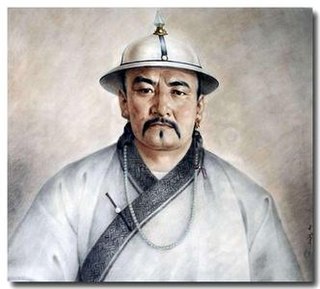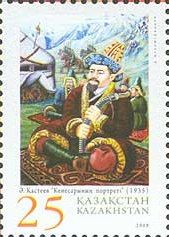
The Dzungar Khanate, also written as the Zunghar Khanate or Junggar Khanate, was an Inner Asian khanate of Oirat Mongol origin. At its greatest extent, it covered an area from southern Siberia in the north to present-day Kyrgyzstan in the south, and from the Great Wall of China in the east to present-day Kazakhstan in the west. The core of the Dzungar Khanate is today part of northern Xinjiang, also called Dzungaria.

Galdan Boshugtu Khan was a Choros Dzungar-Oirat khan of the Dzungar Khanate. As fourth son of Erdeni Batur, founder of the Dzungar Khanate, Galdan was a descendant of Esen Taishi, the powerful Oirat Khan of the Northern Yuan dynasty who united all Mongols in the 15th century. Galdan's mother Yum Agas was a daughter of Torgut khan notGüshi Khan, the first Khoshut-Oirat King of Tibet.

The Kazakh Khanate, in eastern sources known as Ulus of the Kazakhs, Ulus of Jochi, Yurt of Urus, was a Kazakh state in Central Asia, successor of the Golden Horde existing from the 15th to the 19th century, centered on the eastern parts of the Desht-i Qipchaq.

Wāli-ūllah Abū'l-Mansūr Khan, better known as Abylai Khan or Ablai Khan was Khan of the Middle Jüz and was the last independent Kazakh Khan of the Kazakh Khanate before the Khanate was absorbed into the Russian Empire.

A jüz is one of the three main territorial and tribal divisions in the Kypchak Plain area that covers much of the contemporary Kazakhstan. It represents the main tribal division within the ethnic group of the Kazakhs.

The Kalmyk Khanate was an Oirat Mongol khanate on the Eurasian steppe. It extended over modern Kalmykia and surrounding areas in the North Caucasus, including Stavropol and Astrakhan. During their independence, the Kalmyks both raided and allied with Russia in turn, engaging in numerous military expeditions against the Crimean Tatars, the Ottoman Empire, neighboring Muslim tribes, and the highlanders of the North Caucasus. The Khanate was annexed by the Russian Empire in 1771.
Barak Sultan was a descendant of Genghis Khan and a member of the last House of Genghis Khan in the Kazakh Khanate (1221–1847). He was Sultan of the Middle Juz. He is a son of Tursun Khan and great-grandfather of Alikhan Bukeikhanov.

The Battle of Orbulaq was fought in 1643 between Jahangir sultan Khan and Huntaiji Erdeni Batur, resulting in the defeat of Erdeni Batur's army by the Jalantush Bahadur's Kazakhs, led by Jahangir Sultan with the assistance of the Uzbek Emir of Samarkand. The battle, fought during a series of Kazakh-Dzungar Wars, was one of the initial turning points in the liberation war of the Kazakhs against the Dzhungar invasion in the 17th century.

Töle Biy, or Töle Älibekūly was the head biy of the Kazakh senior juz, as well as an author, orator, poet, politician and a public figure. He was born in Jaysan in what is now Shu district, Jambyl oblast in 1663.

The Kazakh–Dzungar Wars (1643–1756) were a series of long conflicts between the Kazakh Juzes and Dzungar Khanate. The strategic goal for the Dzungar Khanate was to increase their territories by taking lands of the Kazakhs. The Dzungars were not only seen as a threat by the Kazakhs, but for the rest of Central Asia and the Russian Empire itself.
Raiymbek Batyr monument is located on the intersection of Raiymbek Avenue and Pushkin Street in Almaty, Kazakhstan.

Kenesary bin Qasym, or Kenesary Qasymuly, Kenesary Khan was the last khan of the Kazakh Khanate, grandson of Ablai Khan, from the clan of Genghisid-Töre.
Anti-Colonial uprising of Eset Batyr — uprising of the Kazakhs of the Junior Jüz against the colonial oppression of the Russian Empire.
Abul Khair–Neplyuyev conflict — the actions of Abul Khair Khan were directed against the Russian Empire, specifically against the Orenburg governor Ivan Neplyuyev. The conflict arose because Neplyuyev supported and maintained a friendship with Abul Khair's opponent, Barak Sultan.
The Battle of Bulanty — large battle between Kazakh and Dzungar Khanates in 1728 during the Kazakh-Dzungar Wars. In the battle, the Kazakhs inflicted a heavy defeat on the Dzungar Khanate's army.
West Siberian conflict or Kazakh–Russian war — large military conflict between the Kazakh Khanate and the Tsardom of Russia, caused by the Kazakh-Russian contradictions in 1680—1690. The conflict was accompanied by raids and attacks on settlements and battles in the south of Western Siberia.
The West Siberian conflict or Kazakh–Russian war was a large military conflict between the Kazakh Khanate and the Tsardom of Russia, caused by the Kazakh-Russian contradictions in 1670–1680. The conflict was accompanied by raids and attacks on settlements and battles in the south of Western Siberia.
Kazakh-Nogai War (1577) — one of the major military invasions of the Kazakh Khanate on the territory of the Nogai Horde.